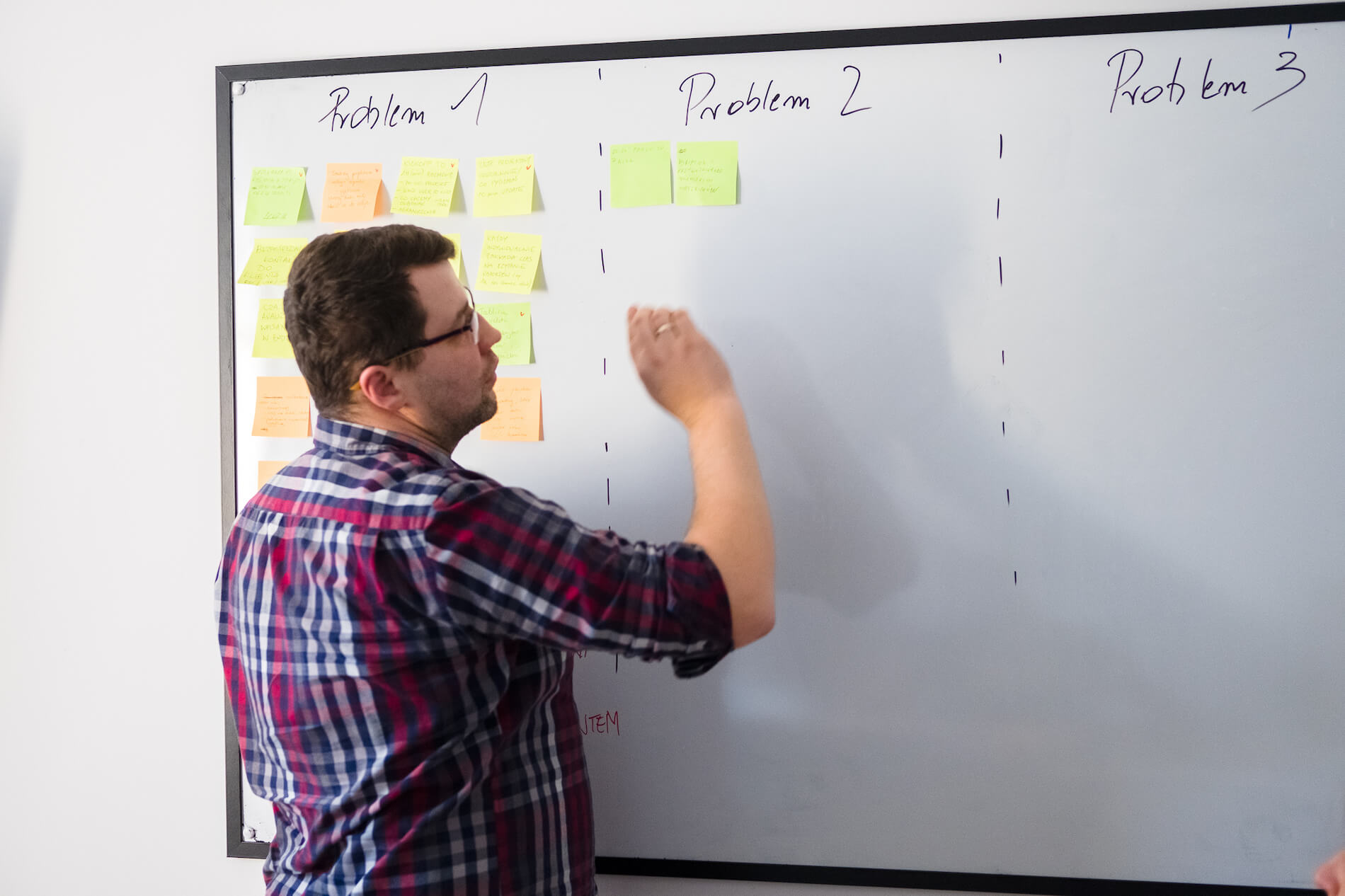Change is the only constant in life – even more so in business. Modern organisations that want to compete for leadership or retain market share must embrace change – otherwise, they will quickly lose their position. It’s obvious, and yet many companies struggle to implement new solutions. What exactly is the reason for this? How to improve change management through UX research?
Change always means discomfort
During the course of the day, including at work, we all do a lot of things according to a set pattern. We often do things intuitively to a certain extent – for example, when typing we do not have to check which key to press every time. However, if we use something very rarely or for the first time – it requires much more effort and concentration from us to do it correctly.
As a result of the change, we can no longer act in accordance with our habits. What we used to do automatically, without thinking about the next step, click, or sentence, after the change, at least initially, will require conscious action, decision-making, and reflection. Therefore, change will always involve some effort, more time, and often discomfort and extra work. This can be a source of frustration.
When managing change in an organisation, it is worth adopting a researcher’s attitude and trying to understand the employees who will be the users of the new solution. If the prospect of a new system does not arouse their enthusiasm, this may be due to at least two things: the aforementioned reluctance to make the extra effort, but also the lack of clear benefits from the change. Then it is worth considering whether it will really be a change for the better and on what basis one can make such a conclusion. Hubert Turaj wrote more about what reactions and attitudes digital transformation may evoke in organisations.
Managing change within your organisation – turn complaining into excitement
Change management is not easy, but there are proven ways to turn employee attitudes from negative to positive.
In UX research, the user is the focus – the same principle applied to change management can remove resistance to implementing a new solution. It can also create keen interest among employees in the fact that the company’s management has not only taken an interest in their everyday problems but has decided to solve them.
Three elements are important in this process:
- finding out in advance what is most important to users,
- choosing a solution that will help the largest possible group of people,
- preparing for the change so that it is as painless as possible.

Talking to employees before designing a solution makes it possible to take into account different points of view and solve many problems at a very early stage, which obviously translates into saving time and money. Examining the team’s everyday problems is also of great importance in the context of building commitment – it proves that the new system really is supposed to meet the users’ expectations; it gives them a sense of empowerment, encourages them to propose new solutions, stimulates innovation.
This is the first step to creating an atmosphere of positive expectation – a simple question to the employee “what can we do to make your work better?” immediately indicates the purpose of implementing change.
Choosing a solution that will help as many people as possible is the next important step. If employees’ major problems are not solved, or the quality of work deteriorates instead of improving, then the good atmosphere will immediately disappear. The team needs to see that in fact their previous comments have been at least partially addressed.
To persuade employees to accept a new solution, it is not enough to make it available to them. Preparing for change involves, among other things, determining who should be informed of the change and how. There are many possibilities, for example:
- information about the fact that the basis for choosing or building a new solution are opinions and problems reported by employees – in the form of a newsletter, (unnamed) thanks at a company meeting for participating in a survey or consultation, a poster or a spot informing about the introduced change
- instructional, educational videos, in the style of tutorials published on YouTube, placed on the intranet, which employees can use in case of problems,
- short information spots or presentations, displayed in the company’s headquarters in visible places, on screens in common areas of the office, in the dining room, lifts, etc,
- individual or group training for each employee, provided for example by immediate superiors.
Why is UX crucial to the change management process?
The role of the researcher is, among other things, to verify assumptions about the change and to investigate user needs. To better describe this process, we can use an example.
From our experience:
One of our clients, a multinational corporation employing thousands of people, approached the researcher with a question:
Why do our employees, privately tech-savvy, call the IT department with every minor problem instead of trying to solve it themselves?
The desirable situation, of course, would be one in which attempts are made to find answers to questions about the system in this order:
- Self-service, or self-maintenance – the employee tries to figure out how to do the task correctly himself,
- Learning from peers – people in the same team or department help each other with problems they cannot solve on their own,
- Requesting a solution – the last lifeline – contact the IT department.
From the employer’s point of view, it was necessary to change the employees’ attitude as soon as possible – to encourage them to be more independent and therefore reduce the number of queries sent to the helpdesk.
The UX researcher, by analysing available helpdesk reports and previous studies of various services in the company and conducting relevant in-depth interviews with employees, quickly found the source of the problem.
It turned out that things weren’t as they seemed at first glance, and the company’s employees are a very committed, great team who just face a lot of obstacles along the way:
- At the self-service stage, the primary problem was that access to resources such as YouTube on the company computer was blocked, and the company’s disk resources were unstructured and unsearchable. As a result, employees were unable to find relevant tutorials during their working time, or they could use their free time to look for solutions, which effectively discouraged many people.
- In the next phase – learning from peers – the researcher was able to identify a large number of committed employees, who focused on helping others. This is very valuable information for a company to know that it has people in its ranks who go beyond their competence to overcome difficulties together with others. Unfortunately, they often lacked the necessary authorisation, for example, to install software that only the IT department had.
- Requesting for a solution, the final step, contacting IT, proved necessary for a variety of reasons, including access management and a lack of information material on the basis of which answers to the most important user questions could be found quickly and simply.
The research was able to verify the assumptions of the change process – “our employees, privately tech-savvy, call the IT department with every minor problem” – and point out that they were wrong. It was also possible to find the true source of the high number of queries to the helpdesk – resource access management that was not optimal.
An additional huge benefit was discovering how committed and willing to help the company’s employees were. This information was later used by the HR department and successfully supported employer branding processes and the design of digital employee experience solutions.
Effective change management is a challenge in which a team of UX and business design specialists can play an important role. Experience in such processes translates into increased effectiveness of solutions, but most of all it allows to avoid many mistakes that can be made along the way.
It is worth remembering that the results of the work of UX researchers are used not only for individual projects, but can also be the basis for many other activities – especially in HR, marketing, and communication departments. When implementing changes within an organisation, the UX researcher provides the necessary analysis and insights, and communicates with users with whom other departments of the company communicate at the same time – it is important that such dialogue is consistent and based on the same principles.
Watch Marketing Academy webinar: How to talk and write about change so users like it – using UX research
Proper coordination of these activities can save the company time and effort. For example, you could send out one questionnaire instead of three, cover more topics in one interview instead of organising several separate surveys in a similar place at a similar time, re-examine the results of surveys already carried out to get a quicker response, and only ask about new issues.
Know your employees' needs
The data obtained thanks to UX research (in such cases we often use ethnographic research) will be a solid input to the marketing brief, a reliable set of information on the basis of which we can improve internal communication, learn about the needs and opinions of employees and address the most important problems that we learned about thanks to the research.
An example can be the channels of communication with employees – during the UX research the employees determine, among other things, where they have so far looked for answers to questions concerning a given topic, and where they would expect to find such information in the future, in what form, etc.
Thanks to such data, the communication department has an easier task regarding the appropriate communication of changes – this definitely increases the chances of success of the whole project in the most crucial point, i.e. effective encouragement of employees to use new solutions.







